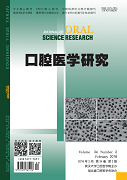|
|
Effect of Periodontal Biotype on Aesthetic Result of Delayed Implantation Underwent GBR in the Aesthetic Zone
DUAN Zi-wen, MA Yu, WANG Bin-jie, AZIGULI Azhati, NIJIATI Tuerxun
2018, 34(2):
176-180.
DOI: 10.13701/j.cnki.kqyxyj.2018.02.017
Objective: To determine whether periodontal biological types influence the aesthetic result of delayed implantation underwent guided bone regeneration (GBR) in the aesthetic zone. Methods: A total of 32 patients were randomly enrolled. Through observation or periodontal probing, 15 cases with thin gingival biotype were included in Group A, and 17 cases with thick gingival biotype were included in Group B. The thickness of gingiva at the crest of alveolar and 3mm under the crest of alveolar was measured before implantation and before the abutment was connected. After the completion of upper structure for 0, 6, and 9 months, both pink aesthetic index (PES) and white aesthetic index of crowns (WES) were evaluated, respectively. Results: As to the thickness of gingiva at 3 mm under the crest of alveolar bone, for Group A, it (1.39±0.34 mm) was less than 1.5mm before implantation (P>0.05); for Group B, it was more than 1.5 mm before and after implantation (P<0.05). As to the thickness of gingiva at the crest of alveolar bone, for both Group A and Group B, it was more than 1.5 mm before and after implantation (P<0.05). There was difference between Group A and Group B before and after implantation (P<0.05). The scores of PES after 0, 6, and 9 months were: Group A (9.90±0.99), (11.53±0.82), (10.77±0.77), Group B (11.03±0.80), (12.32±0.64), (11.59±0.61). Group B was better than Group A (P<0.05) and there was significant difference among different time points within each group. The scores of WES after 0, 6, and 9 months were: Group A (7.23±0.63), (8.20±0.48), (7.83±0.59), Group B (7.50±0.56), (8.38±0.49), (8.15±0.61). There was no difference between Group A and B (P>0.05) and significant difference among different time points. There was significant correlation between both groups. Conclusion: 1) The delayed implantation underwent GBR can increase the gingival thickness at the alveolar crest and 3mm under the alveolar crest; 2) The patients with thick gingival biotype were more likely to acquire good red aesthetic result during the delayed implantation underwent GBR. 3) PES is positively related to WES in patients with different gingival biotype after delayed implantation underwent GBR (r2=0.185).
References |
Related Articles |
Metrics
|

